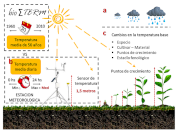Strengths and limitations of Bio∑TERM®, a thermal time calculator program
DOI:
https://doi.org/10.25260/EA.24.34.1.0.2266Keywords:
growth, mean temperatures, base temperature, modelingAbstract
Temperature is one of the main determinants of plant growth. Growth simulation models based on base temperatures and thermal accumulation requirements for each species or crop are widely used to model their behavior at different latitudes. But the calculation of the thermal time necessary to complete certain growth phases requires as input the average daily temperatures of the period to be calculated and the base temperature (Tb) of the species, information that is sometimes difficult to obtain. The Bio∑TERM® program was designed with the objective of facilitating and simplifying the conversion of units from calendar time to thermal time and vice versa in Argentina. For this, it has two databases, one with average daily temperatures for the entire country for 50 years and another with base temperatures of different species and cultivars. Both databases allow quick and simple calculation, transforming calendar times in thermals for a wide set of species, and even for those that are not incorporated into it and the user knows their Tb, or transform a known thermal time into a calendar. The program proved to be very accurate, when real vs. calculated data were compared, for different time series of average temperatures, showing a high degree of adjustment when real data are not available. The Bio∑TERM® program tries to be a powerful tool and at the same time provide a simple solution both for researchers who wish to transmit or disseminate knowledge that is very difficult to apply in calendar time, as well as for advisors and producers who want to use said knowledge in a more friendly way.
References
Addae, P. C., and C. J. Pearson. 1992. Thermal requirement for germination and seedling growth of wheat. Australian Journal of Agricultural Research 43(3):585-594. https://doi.org/10.1071/ar9920585.
Andrade, F. H., A. G. Cirilo, S. A. Uhart, and M. E. Otegui. 1996. Ecofisiología del cultivo de maíz. Dekalb Press. Pp. 292.
Arnold, S. M., and J. L. Monteith. 1974. Plant development and mean temperature in a Teesdale habitat. The Journal of Ecology 62(3):711-720. https://doi.org/10.2307/2258951.
Blacklow, W. M. 1972. Influence of Temperature on Germination and Elongation of the Radicle and Shoot of Corn (Zea mays L.) 1. Crop Science 12(5):647-650. https://doi.org/10.2135/cropsci1972.0011183x001200050028x.
Christian, K. R. 1977. Effects of the environment of the growth of alfalfa. Advances in Agronomy 29:183-227. https://doi.org/10.1016/S0065-2113(08)60219-9.
Connor, D. J., and V. O. Sadras. 1992. Physiology of yield expression in sunflower. Field Crops Research 30(3-4):333-389. https://doi.org/10.1016/0378-4290(92)90006-u.
Hatfield, J. L., and J. H. Prueger. 2015. Temperature extremes: Effect on plant growth and development. Weather and climate extremes 10:4-10. https://doi.org/10.1016/j.wace.2015.08.001.
Fick, G. W., D. A. Holt, and D. G. Lugg. 1988. Environmental physiology and crop growth. Pp. 163-194 en A. A. Hanson, D. K. Barnes and R. R. Hill Jr. (eds.). Alfalfa and Alfalfa Improvement. Agronomy Monograph 29. American Society of Agronomy, Madison, EUA. https://doi.org/10.2134/agronmonogr29.c5.
Grimm, S. S., J. W. Jones, K. J. Boote, and D. C. Herzog. 1994. Modeling the occurrence of reproductive stages after flowering for four soybean cultivars. Agronomy Journal 86(1):31-38. https://doi.org/10.2134/agronj1994.00021962008600010007x.
Kiniry, J. R., J. T. Ritchie, R. L. Musser, E. P. Flint, and W. C. Iwig. 1983. The photoperiod sensitive interval in maize 1. Agronomy Journal 75(4):687-690. https://doi.org/10.2134/agronj1983.00021962007500040026x.
Miralles, D. J., L. B. Windauer, and N. V. Gómez. 2003. Factores que regulan el desarrollo de los cultivos de granos (Capitulo 5). Pp. 61-74 en E. H. Satorre, R. L. A. Benech, G. A. Slafer, E. B. De la Fuente, D. J. Miralles, M. E. Otegui and R. Savin (eds.). Producción de granos: Bases funcionales para su manejo. Facultad de Agronomía, UBA.
Monteith, J. L. 1977. Climate and the efficiency of crop production in Britain. Philosophical Transactions of the Royal Society of London. B, Biological Sciences 281(980):277-294. https://doi.org/10.1098/rstb.1977.0140.
Porter, J. R., and R. Delecolle. 1988. Interaction of temperature with other environmental factors in controlling the development of plants. Symposia of the Society for Experimental Biology 42:133-156.
Raper Jr., D. C., and P. J. Kramer. 1987. Stress physiology. Pp. 590-605 en J. R. Wilcox (ed.). Soybeans: improvement production and uses. Agronomy Series 16.
Ritchie, J. T., and D. S. Nesmith. 1991. Temperature and crop development. Modeling Plant and Soil Systems 31:5-29. https://doi.org/10.2134/agronmonogr31.c2.
Sadras, V. O., M. Ferreiro, F. Gutheim, and A. G. Kantolic. 2000. Desarrollo fenológico y su respuesta a temperatura y fotoperíodo (Capitulo 2). En F. H. Andrade and V. O. Sadras (eds.). Bases Para el Manejo del Maíz, el Girasol y la Soja. Estación Experimental Agropecuaria, Instituto Nacional de Tecnología Agropecuaria Balcarce - Facultad de Ciencias Agrarias, Universidad Nacional de Mar del Plata Buenos Aires, Argentina.
Vincent, C. D. 1989. Recent advances in modelling crop response to temperature. Outlook on Agriculture 18(2):54-57. https://doi.org/10.1177/003072708901800202.
Warrington, I. J., and E. T. Kanemasu. 1983. Corn growth response to temperature and photoperiod I. Seedling emergence, tassel initiation, and anthesis. Agronomy Journal 75(5):749-754. https://doi.org/10.2134/agronj1983.00021962007500050008x.
Źróbek-Sokolnik, A. 2012. Temperature Stress and Responses of Plants. Pp. 113-134 en P. Ahmad and M. Prasad (eds.). Environmental Adaptations and Stress Tolerance of Plants in the Era of Climate Change. Springer, New York, NY. https://doi.org/10.1007/978-1-4614-0815-4_5.

Downloads
Published
How to Cite
Issue
Section
License
Copyright (c) 2024 Nicolás Bertram

This work is licensed under a Creative Commons Attribution 4.0 International License.
Authors retain their rights as follows: 1) by granting the journal the right to its first publication, and 2) by registering the published article with a Creative Commons Attribution License (CC-BY 4.0), which allows authors and third parties to view and use it as long as they clearly mention its origin (citation or reference, including authorship and first publication in this journal). Authors can make other non-exclusive distribution agreements as long as they clearly indicate their origin and are encouraged to widely share and disseminate the published version of their work.


